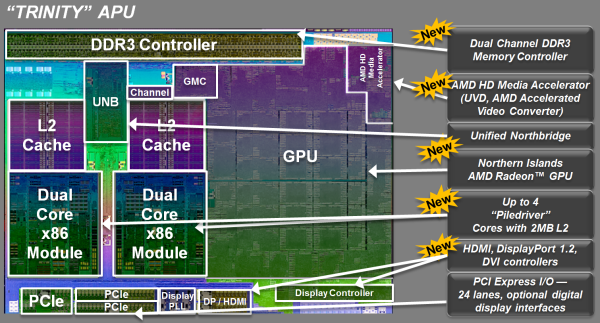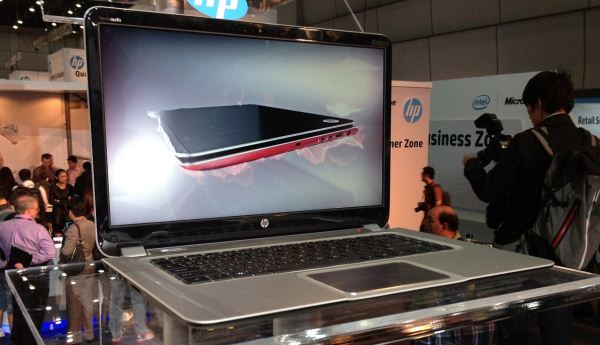The AMD Trinity Review (A10-4600M): A New Hope
by Jarred Walton on May 15, 2012 12:00 AM ESTConclusion: What Makes a Trinity?
I have often wondered about where AMD came up with the codename Trinity (other than the river name, of course). Was it a reference to this being AMD’s third APU? Or maybe AMD was gunning for the Holy Trinity of Performance, Battery Life, and Cost—get wins in all three areas and you’d have a guaranteed best seller! If that’s what AMD was hoping to accomplish, they’ve got a good foundation but we’ll need to see what the laptop OEMs come up with before issuing a final verdict.
To recap, Trinity is AMD’s continued journey down the path they started with Llano. Both CPU and GPU performance have improved over Llano. The general purpose CPU performance gap vs. Intel is somewhere in the 20—25% range, while the GPU advantage continues to be significantly in AMD's favor. It is surprising that Intel's HD 4000 is able to win even in some tests, but overall AMD continues to deliver better GPU performance even compared to Ivy Bridge. It's worth pointing out that the concerns about AMD's battery life from a few years ago are now clearly put to rest. At least at the TDPs we've tested, AMD is easily competitive with Intel on battery life.
AMD's GPU accelerated software lineup this time around is significantly better than it was with Llano, but we're still not quite where we need to be yet. I will hand it to AMD though, progress is clearly being made. Battery life is generally a step forward vs. Llano, which is more than we've been able to say about Ivy Bridge thus far.
The improvements in Piledriver really appear to have saved Trinity. What was a very difficult to recommend architecture in AMD's FX products has really been improved to the point where it's suitable for mobile work. AMD couldn't push performance as aggressively as it would have liked given that it's still on a 32nm process and the APU needs to make money. A move to 2x-nm could help tremendously. Similarly the move to a more efficient VLIW4 GPU architecture and additional tuning helped give AMD a boost in GPU performance without increasing die size. Overall, Trinity is a very well designed part given the process constraints AMD was faced with.
As a notebook platform, Trinity's CPU performance isn’t going to set any new records but it’s certainly fast enough for most users; battery life isn’t at the head of the class, but it’s better than just about anything that doesn’t qualify as an ultrabook; and finally there’s the question of cost. That last item isn’t really in AMD’s control, as the final cost of a laptop is a product of many design decisions, so let’s do some quick investigation into laptop pricing.
If you figure on memory, motherboard, chassis, LCD, and storage as all being the same, a typical laptop will have a starting price point of around $300—for a cheap, injection molded plastic shell, 4GB RAM, a 5400RPM HDD, a 1366x768 TN panel, and a no-frills feature set. Take that same basic platform and you can make an Intel laptop and have a BoM (Bill of Materials) cost of around $450, or you can make an AMD laptop and your BoM might start at $400. Depending on what other upgrades an OEM makes, as well as marketing, R&D, and profit, and we end up at a final price tag that might be $600 for a Trinity laptop compared to $700 for an Ivy Bridge laptop. The problem is that AMD doesn't just compete against vanilla Ivy Bridge; it has to compete against all the existing laptops as well.
Right now, Llano A8 laptops at Newegg have a starting price of $480 for an A8-3500M Acer Aspire, and they range up to $700 for a 17.3” HP dv7. The highest performance laptop of the bunch is probably Samsung’s Series 3, which uses an A8-3510MX APU and goes for $680. I suspect we’ll see similar pricing for Trinity laptops. On the Sandy Bridge Core i3/i5 side of the fence, Newegg has a much larger selection of laptops, starting at $430 for a Lenovo G570, $550 for the cheapest Core i5 model (again from Acer), and going up to $680 or more for laptops with Core i5 and NVIDIA Optimus graphics. Or if you prefer some place other than Newegg, you can find Core i5-2450M with GT 540M in Acer’s AS4830TG for $600.
That pretty much defines the maximum price we should expect people to pay for Trinity, as Core i5 with Optimus will deliver better CPU and GPU performance based on our test results. Obviously there are other factors to consider, like build quality of the laptop(s), display quality, battery life, and features, but most people shopping for an inexpensive laptop are going to be looking at cost first and features second. On the other hand, if you want style as a consideration, HP’s new sleekbooks will have Trinity versions starting at $600 for 15.6” and $700 for 14”—though it’s not clear which APU you’ll get at those prices. As long as last-generation Sandy Bridge laptops are at clearing house prices, though, AMD’s partners are going to need to be under $600 for something like the A10-4600M laptop we’re reviewing today. Assuming they can manage that, Trinity should see plenty of volume with the back to school season coming over the next few months.
For those who are interested in more than just the bottom line, as usual the best laptop for you may not be the best laptop for everyone. Trinity in a 14” form factor like our prototype would make for a great laptop to lug around campus for a few years. It would be fast enough for most tasks, small enough to not break your back, battery life would be long enough to last through a full day of classes, and the price would be low enough to not break your bank. And if mom and dad are footing the bill, you even get to disguise the fact that it’s a gaming capable laptop by not having a discrete GPU specifically called out on the features list. On the other hand, if you’re after a higher performance laptop or you want a “real” gaming system—something that can hand high detail settings at 1600x900 for instance—your best bet continues to be laptops with an Intel CPU and a discrete GPU from NVIDIA, at least of the GT 640M level—I’d say AMD GPUs as well, but I’m still waiting for a better switchable graphics solution.
At this point, AMD has done everything they can to provide a compelling mobile solution. The difficulty is that there's no longer a single laptop configuration that will be "best" for everyone, and Trinity only serves to further muddy the water. Intel continues to offer better CPU performance, and if you need graphics—which mostly means you want to play games—they have a good partner with NVIDIA. AMD on the other hand is delivering better integrated graphics performance with less CPU power, and depending on what you want to do that might be a more well rounded approach to mobile computing. What we need to see now are actual laptops and their prices. To trot out a tired old saying once more, "There are no bad products; only bad prices." Now it's up to AMD's partners to make sure Trinity laptops are priced appropriately.












271 Comments
View All Comments
KompuKare - Tuesday, May 15, 2012 - link
What AMD really needs is a better IMC. Look at this recent computerbase article on IB and RAM:http://www.computerbase.de/artikel/arbeitsspeicher...
http://translate.google.co.uk/translate?hl=en&...
Unlike Llano IB doesn't perform a lot different as long it's running at DDR3-1600. Which to me says that Intel's IMC is a lot more efficient than AMD's. Ironic I know since AMD brought IMC to the x86 space, but the problem is that Intel have such a huge R&D budget compared to AMD.
I'll be interested in Jarred trying that review sample with DDr3-1333 too.
Assimilator87 - Tuesday, May 15, 2012 - link
A piece of my soul was crushed when I saw the HD 4000 ahead of Trinity. I don't care what the situation is, that should NEVER happen. 22nm and GCN can't come soon enough.ET - Tuesday, May 15, 2012 - link
While the HD 4000 still gets too low performance on occasion, I was generally impressed with it in this comparison. Intel GPUs have come a long way.As for Trinity, it looks like a well rounded solution. I'm more interested in the 17W version, as an alternative to Brazos. I like my Thinkpad x120e, and even run games on it occasionally, but it's still pretty weak.
ET - Tuesday, May 15, 2012 - link
"PCI Express support in Trinity remains at PCEe 2.0"althaz - Tuesday, May 15, 2012 - link
I'd pay $700 for an ultrabook-type laptop with this in it - provided it had a 128Gb Samsung SSD, a decent keyboard and an above-average screen.Ideally I'd like to get a convertible tablet with windows 8 on it powered by this. In laptop mode it's a portable gaming machine, in tablet mode a pretty nice tablet. Something 11.6"ish akin to the Transformer Prime from Asus in form factor
Riek - Tuesday, May 15, 2012 - link
Would it be possible to include power consumption (or batterly life) while gaming?Would it also be possible to add a cpu frequency - gpu frequency graph during some workloads? To see how turbo3.0 shapes up and how well the gpu turbo is implemented and used?
From my understanding gpu gets priority in turbo, but a trinity at 2.3GHz will just limit the performance in gaming. I wonder if the turbo is shaped up like that.
JarredWalton - Tuesday, May 15, 2012 - link
I noted battery life while looping 3DMark06 was 77 minutes. If we calculate power draw, that works out to around 43W. I also just checked AC power draw at the outlet during the same test, and the average power use was around 50W (45-55W range, but mostly right around 50). Accounting for AC adapter inefficiencies, if it's 80-85% efficient the laptop is using around 40-43W.Riek - Tuesday, May 15, 2012 - link
Yeah looked over that. So gaming wise llano is still a better option in regards to batterly life (alot better).Sandy bridge would be the worst choice. (as it gives the worst performance).
I'm suprised trinity and IvyB are so close in terms of 3dmark06 performance and battery life.
deathpony - Tuesday, May 15, 2012 - link
Hi, i have an AMD A6-3500http://valid.canardpc.com/show_oc.php?id=2369937
Gigabyte GA-A75M-UD2H
AMD Radeon HD 6530D
http://www.techpowerup.com/gpuz/63we6/
For some reason i was able to Undervolt the APU and push the clock to 2 Ghz while retaining stability. Also by raising the clock this much i got performance increase in double digits, can you test it out with Trinity? Thanks!
JarredWalton - Tuesday, May 15, 2012 - link
Unfortunately, the Trinity BIOS is pretty much useless as far as undervolting/overclocking/etc. are concerned. I'd be interested in testing such items, but we'd need a far more capable BIOS/motherboard than this laptop has.